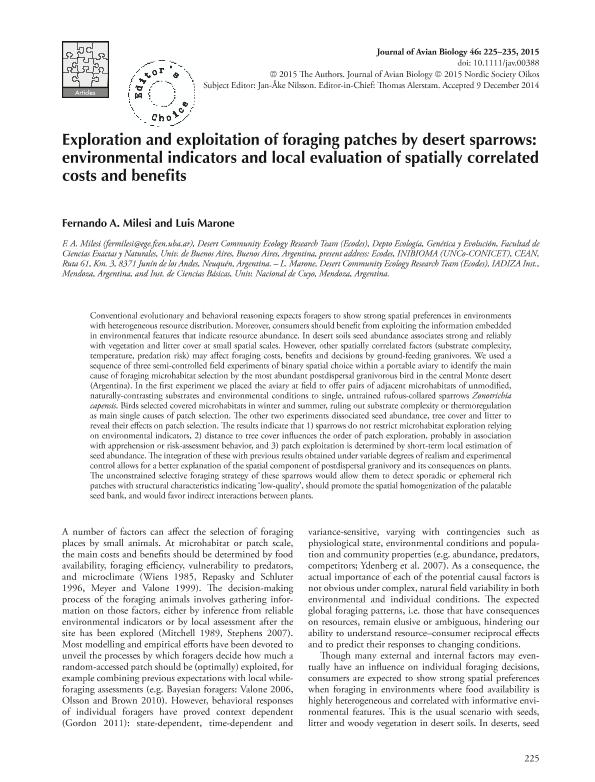Mostrar el registro sencillo del ítem
dc.contributor.author
Milesi, Fernando Adrian

dc.contributor.author
Marone, Luis

dc.date.available
2017-01-27T21:15:25Z
dc.date.issued
2015-05
dc.identifier.citation
Milesi, Fernando Adrian; Marone, Luis; Exploration and exploitation of foraging patches by desert sparrows: environmental indicators and local evaluation of spatially correlated costs and benefits; Wiley; Journal Of Avian Biology; 46; 3; 5-2015; 225-235
dc.identifier.uri
http://hdl.handle.net/11336/12142
dc.description.abstract
Conventional evolutionary and behavioral reasoning expects foragers to show strong spatial preferences in environments with heterogeneous resource distribution. Moreover, consumers should benefit from exploiting the information embedded in environmental features that indicate resource abundance. In desert soils seed abundance associates strong and reliably with vegetation and litter cover at small spatial scales. However, other spatially correlated factors (substrate complexity, temperature, predation risk) may affect foraging costs, benefits and decisions by ground-feeding granivores. We used a sequence of three semi-controlled field experiments of binary spatial choice within a portable aviary to identify the main cause of foraging microhabitat selection by the most abundant postdispersal granivorous bird in the central Monte desert (Argentina). In the first experiment we placed the aviary at field to offer pairs of adjacent microhabitats of unmodified, naturally-contrasting substrates and environmental conditions to single, untrained rufous-collared sparrows Zonotrichia capensis. Birds selected covered microhabitats in winter and summer, ruling out substrate complexity or thermoregulation as main single causes of patch selection. The other two experiments dissociated seed abundance, tree cover and litter to reveal their effects on patch selection. The results indicate that 1) sparrows do not restrict microhabitat exploration relying on environmental indicators, 2) distance to tree cover influences the order of patch exploration, probably in association with apprehension or risk-assessment behavior, and 3) patch exploitation is determined by short-term local estimation of seed abundance. The integration of these with previous results obtained under variable degrees of realism and experimental control allows for a better explanation of the spatial component of postdispersal granivory and its consequences on plants. The unconstrained selective foraging strategy of these sparrows would allow them to detect sporadic or ephemeral rich patches with structural characteristics indicating ‘low-quality’, should promote the spatial homogenization of the palatable seed bank, and would favor indirect interactions between plants.
dc.format
application/pdf
dc.language.iso
eng
dc.publisher
Wiley

dc.rights
info:eu-repo/semantics/openAccess
dc.rights.uri
https://creativecommons.org/licenses/by-nc-sa/2.5/ar/
dc.subject
Seed Predation
dc.subject
Heterogeneity
dc.subject
Rufous-Collared Sparrow
dc.subject.classification
Zoología, Ornitología, Entomología, Etología

dc.subject.classification
Ciencias Biológicas

dc.subject.classification
CIENCIAS NATURALES Y EXACTAS

dc.subject.classification
Ecología

dc.subject.classification
Ciencias Biológicas

dc.subject.classification
CIENCIAS NATURALES Y EXACTAS

dc.title
Exploration and exploitation of foraging patches by desert sparrows: environmental indicators and local evaluation of spatially correlated costs and benefits
dc.type
info:eu-repo/semantics/article
dc.type
info:ar-repo/semantics/artículo
dc.type
info:eu-repo/semantics/publishedVersion
dc.date.updated
2016-12-12T14:22:36Z
dc.identifier.eissn
1600-048X
dc.journal.volume
46
dc.journal.number
3
dc.journal.pagination
225-235
dc.journal.pais
Estados Unidos

dc.journal.ciudad
Hoboken
dc.description.fil
Fil: Milesi, Fernando Adrian. Universidad de Buenos Aires. Facultad de Ciencias Exactas y Naturales. Departamento de Ecología, Genética y Evolución. Grupo de Investigación en Ecologia de Comunidades del Desierto; Argentina. Universidad de Buenos Aires. Facultad de Ciencias Exactas y Naturales. Departamento de Ecología, Genética y Evolución; Argentina. Consejo Nacional de Investigaciones Científicas y Técnicas. Centro Científico Tecnológico Patagonia Norte. Instituto de Investigación en Biodiversidad y Medioambiente; Argentina. Universidad Nacional del Comahue; Argentina
dc.description.fil
Fil: Marone, Luis. Universidad de Buenos Aires. Facultad de Ciencias Exactas y Naturales. Departamento de Ecología, Genética y Evolución. Grupo de Investigación en Ecologia de Comunidades del Desierto; Argentina. Consejo Nacional de Investigaciones Científicas y Técnicas. Centro Científico Tecnológico Mendoza. Instituto Argentino de Investigaciones de Zonas Aridas; Argentina. Universidad Nacional de Cuyo; Argentina
dc.journal.title
Journal Of Avian Biology

dc.relation.alternativeid
info:eu-repo/semantics/altIdentifier/url/http://dx.doi.org/10.1111/jav.00388
dc.relation.alternativeid
info:eu-repo/semantics/altIdentifier/url/http://onlinelibrary.wiley.com/doi/10.1111/jav.00388/abstract
Archivos asociados
